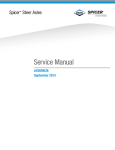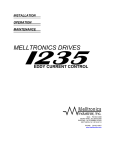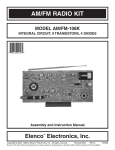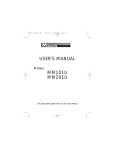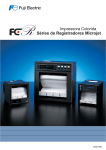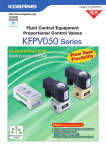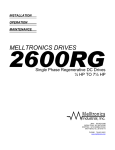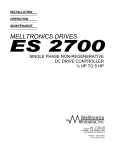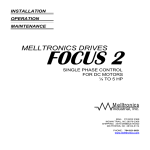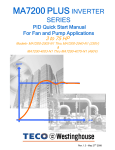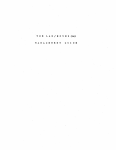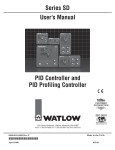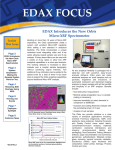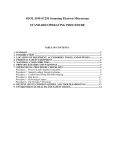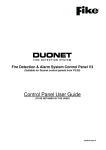Download Melltronics F1 F1 User Manual
Transcript
INSTALLATION OPERATION MAINTENANCE MELLTRONICS DRIVES Series Adjustable DC Drives 1/4HP to 2HP MAIL: PO BOX 2368 INDIAN TRAIL, NC 28079-2368 SHIPPING: 3479 GRIBBLE ROAD MATTHEWS, NC 28104-8114 PHONE: 704-821-6651 www.melltronics.com F1 Manual SAFETY WARNINGS Improper installation or operation of this drive control may cause serious injury to personnel or equipment. Before you begin installation or operation of this equipment you should thoroughly read this instruction manual and any supplementary operating instructions provided. The drive must be installed and grounded in accordance with local and national electrical codes. To reduce potential of electric shock, disconnect all power sources before initiating any maintenance or repairs. Keep fingers and foreign objects away from ventilation and other openings. Keep air passages clear. Potentially lethal voltages exist within the control unit and connections. Use extreme caution during installation and startup. BRANCH CIRCUIT PROTECTION Branch circuit protection is to be provided by end user. OVERLOAD PROTECTION Overload protection must be provided per national electric code article 430, Section C. INITIAL CHECKS Before installing the drive control, check the unit for physical damage sustained during shipment. Remove all shipping restraints and padding. Shortage or damage should be reported promptly to CARRIER and your distributor. INSTALLATION LOCATION OF CONTROL Controls are suitable for most factory areas where industrial equipment is installed. The control and operator’s control station should be installed in a wellventilated area. Locations subject to steam vapors or excessive moisture, oil vapors, flammable or combustible vapors, chemical fumes, corrosive gases or liquids, excessive dirt, dust or lint should be avoided unless an appropriate enclosure has been supplied or a clean air supply is provided to the enclosure. The location should be dry and the ambient temperature should not exceed o 104 F. If the mounting location is subject to vibration, the enclosure should be shock-mounted. If the enclosure has a ventilating fan, avoid, wherever possible, and environment having a high foreign-matter content otherwise the filters will have to be changed more frequently or micron-filters installed. Should a control enclosure require cleaning on the inside, a low pressure vacuum cleaner is recommended, not an air hose, because of the possible oil vapor in the compressed air and its high pressure. USING THIS INSTRUCTION BOOKLET Whenever equipment modifications are not involved, the information contained in this instruction booklet describes drive system setup and operating procedures of most drive applications. This manual should be provided to end user as it also provides the information required by the customer to install and maintain the equipment. F1 DRIVE – RECEIVING AND STORAGE Please record information below before installing the unit and use these numbers when communicating with the factory. CUSTOMER HORSEPOWER RATING VOLTAGE MODIFICATIONS MELLTRONICS 2 Rev. 02/26/2009 F1 Manual SECTION 1 SECTION 2 SECTION 3 SECTION 4 SECTION 5 SECTION 6 SECTION 7 SECTION 8 SECTION 9 SECTION 10 SECTION 11 SECTION 12 SECTION 13 Table of Contents SPECIFICATIONS........................................................................ 4 CONTROL FEATURES ................................................................ 5 MODIFICATION FEATURES ....................................................... 7 FUNCTIONAL DESCRIPTION ..................................................... 8 INSTALLATION .......................................................................... 13 SET-UP PROCEDURE............................................................... 15 INSTALLATION CHECKS .......................................................... 18 OPERATING INSTRUCTIONS................................................... 19 TROUBLESHOOTING ............................................................... 21 CONNECTIONS DIAGRAMS .................................................... 22 SCHEMATIC DIAGRAMS.......................................................... 28 SPARE PARTS.......................................................................... 30 WARRANTY .............................................................................. 35 Table of Figures Figure 1: ENCLOSED CONTROL........................................................................................................... 5 Figure 2: CHASSIS CONTROL............................................................................................................... 6 Figure 3: CONTACTOR .......................................................................................................................... 7 Figure 4: FWD/REV ................................................................................................................................ 7 Figure 5: DYNAMIC BRAKING ............................................................................................................... 7 Figure 6: POWER BRIDGE ASSEMBLY ................................................................................................ 9 Figure 7: RUN/STOP LOGIC (enclosed control) ................................................................................... 10 Figure 8: RUN/STOP LOGIC (chassis control) ..................................................................................... 10 Figure 9: CONTROL CIRCUIT BLOCK DIAGRAM ............................................................................... 12 Figure 10: ENCLOSED CONTROL........................................................................................................ 15 Figure 11: CHASSIS CONTROL............................................................................................................ 16 Figure 12: ENCLOSED CONTROL 242-1000-I...................................................................................... 22 Figure 13: ENCLOSED CONTROL W/ARM CONTACTOR & DYNAMIC BRAKING 242-1001-I........... 23 Figure 14: CHASSIS CONTROL 242-1002-I.......................................................................................... 24 Figure 15: CHASSIS CONTROL W/ARM CONTACTOR & DYNAMIC BRAKING 242-1003-I............... 25 Figure 16: ENCLOSED CONTROL WITH REVERSING & DYNAMIC BRAKING 242-1004-I ............... 26 Figure 17: CHASSIS CONTROL WITH REVERSING & DYNAMIC BRAKING 242-1005-I ................... 27 Figure 18: ENCLOSURE MOUNTED CONTROLLER 242-1000 ........................................................... 28 Figure 19: CHASSIS CONTROLLER 242-1001..................................................................................... 29 MELLTRONICS 3 Rev. 02/26/2009 F1 Manual SECTION 1 SPECIFICATIONS Horsepower Ratings Input Power 120VAC 1/50-60HZ .............................................................. ¼ -1HP 240VAC 1/50-60HZ ............................................................. ½ - 2HP Drive S.F. (Max ratings).................................................................. 1.0 IR Compensation Adjustment........................................................ STD Maximum Speed Adjust (1% of rated speed) ......................................................................0-30% Current Limit (% of selected rating) ........................................... Fixed 150 Acceleration (fixed)......................................................................2-3 Sec Speed Regulation: Armature Voltage Feedback For a 95% Load Change ......................................2-5% of Top Speed For all other variables* Operator Functions Speed Adjust................................................................Standard Power On/Off, Run/Stop ..................................Cust. Supplied Standard Forward/Reverse............................................................Option Operating Conditions Altitude (without de-rating) .....................................................3300’ ...................................................................................... Above sea level Ambient Temperature 0 Chassis Unit .................................................................. 0-55 C Enclosed Unit ................................................................ 0-400 C Chassis Mount Space Req. For TENV enclosure.........................................800 cu. In./HP Not Appl. Line voltage Variation...................................................48-62 HZ Overload Capacity as a Percent of max rating)................................................150%/1min. Field Supply .................................................................. 3 amps Efficiency Controller Only (Min.)............................................... 98% Motor & Controller (Typ.).......................................... 86% *Voltage Regulated – Changes up to 15% of top speed can result from temperature, voltage, and frequency variations plus drift. MELLTRONICS 4 Rev. 02/26/2009 F1 Manual SECTION 2 CONTROL FEATURES Figure 1: ENCLOSED CONTROL 2.1 STANDARD FEATURES: CONNECTABLE for either speed regulation or torque regulation. CONNECTABLE for 120 VAC (1/4-1HP) OR 240VAC (1/2-2HP). CONTROL RELAY – provides momentary Run/Stop operation. Drive cannot restart without pushing Run button if AC power is momentarily disconnected and restored. STANDARD ADJUSTMENTS – maximum speed; minimum speed; I.R. compensation. RUGGED DUST AND OIL-TIGHT ENCLOSURE MELLTRONICS 5 Rev. 02/26/2009 F1 Manual CURRENT LIMITING – protects drive from overloads. Selectable to match motor rating. IN T E G R A T E D C I R C U I T OPERATIONAL AMPLIFIER – for high gain, fast response and excellent linearity. BUILT-IN ACCELERATION RATE CONTROL – 2-3 seconds. ENCAPSULATED SCR BRIDGE POWER CUBE – full wave. VARISTOR TRANSIENT VOLTAGE – provides trouble-free operation. Figure 2: CHASSIS CONTROL MELLTRONICS 6 Rev. 02/26/2009 F1 Manual SECTION 3 MODIFICATION FEATURES ARMATURE CONTACTOR This option positively disconnects the motor from the controller when the stop button is depressed. 3.1 ARMATURE REVERSING CONTACTOR Allows the operator to reverse rotation of the motor. It consists of two full rated double pole DC loop contactors (each 2 pole). To reverse the drive rotation, the operator must stop the motor, switch the FWD/REV switch to the desired direction and restart the drive. 3.2 Figure 3: CONTACTOR NEMA 4 KIT/NEMA 12 KIT Allows the enclosure to provide protection for the enclosure equipment against splashing water, seepage of water, fall or hose-directed water, and severe external condensation, while also providing a rugged oil-tight package. 3.3 Figure 4: FWD/REV 3.4 DYNAMIC BRAKING Provides a fast, smooth stop when the stop button is depressed. Figure 5: DYNAMIC BRAKING MELLTRONICS 7 Rev. 02/26/2009 F1 Manual SECTION 4 FUNCTIONAL DESCRIPTION This diode also helps the SCR to return to its blocking state. Three points of interest can be found on the diagram (Figure 6). The first of which is armature voltage feedback signal. This signal is used by the drive to determine when the drive is at the correct operating speed (voltage) as requested by the operator’s speed potentiometer. The second of the signals is the current feedback signal. This signal provides current information to the drive’s inner current loop. The third point of interest is the location of control circuit common which is tied to the positive terminal of the power bridge. NOTE: The control circuit common is “floating” and should never be tied to earth common. Otherwise, a catastrophic destruction of the drive will occur. The Motor shunt field supply is also shown in Figure 6. Diodes D1, D2, D4 and D5 form a single phase full wave uncontrolled rectifier bridge. This bridge will produce a 200VDC field voltage when operated at 240VAC and 100VDC field voltage when operated at 120VAC. The motor shunt field supply is rated at 3 amps. 4.1 GENERAL The F1 DC drive controllers contain all the necessary circuitry to perform the primary control functions required to control the speed of, or current supplied to, small horsepower DC motors (shunt wound or permanent magnet). This controller is available in two models: (1) Enclosure mounted, and (2) Chassis Mounted. Maximum versatility has been designed into these drives by the use of jumper programming. Such functions as input voltage selection (240/120VAC), armature voltage selection (High – 180VDC, Low – 90VDC), motor current range (High, Medium, and Low), and speed/current regulation are achieved by customer selection of the jumper positions. 4.2 POWER BRIDGE AND FIELD SUPPLY The power bridge supplied in these drives is an encapsulated SCR power cube consisting of two SCRs and three diodes. Basic operation is as follows: when L1 is more positive with respect to L2, SCR1 is gated “on” at a particular phase angle commanded by the drive regulator circuitry. Current will then flow from L1, through SCR1, the shunt resistor, the drive motor, diode D2, and back to L2. When L2 is more positive with respect to L1, SCR2 is gated “on” and current will flow from L2, through SCR2, the shunt resistor, the drive motor, and back to L1 through diode D1. This action results in a positive flow of current through the motor. Diode D3 is known as a “free wheeling” diode whose purpose is to insure continuity of the load current when the previously “fired” SCR becomes reverse biased. MELLTRONICS 8 Rev. 02/26/2009 F1 Manual L2 L1 F1 MOTOR FIELD F2 (- ) A2 ARMATURE VOLTAGE FEEEDBACK SIGNAL M D1 A1 D3 CURRENT FEEDBACK SIGNAL SCR2 GATE2 SCR1 GATE1 ENCAPSULATED SCR POWER CUBE SHUNT (+) CONTROL CIRCUIT COMMON Figure 6: POWER BRIDGE ASSEMBLY 4.3 RUN/STOP LOGIC The standard run/stop logic can be found in Figure 7 and Figure 8. Operation is as follows: When the run button is momentarily depressed, 24 volts DC is supplied to CRR (Control run Relay). This will then pick up relay CRR. When this relay picks up, a normally open contact will close and thus seal in the run relay (CRR). When this occurs, 24VDC will then be present on Terminal #4 and #5. This voltage is then directed to two places. The first is the speed potentiometer voltage supply. This will cause the run LED to light and 10-volt reference to MELLTRONICS appear at Terminal #6 (top of speed potentiometer). This voltage is zener regulated and provides protection to the 24-volt supply in the event of Terminal #6 being shorted to common. The second place in which this voltage is directed is a transistor clamp circuit. This will release the gate drives whenever the dive is placed in the run mode. This circuit provides three important functions: (1) it prevents misfiring of the SCRs when power is first applied to the drive, (2) it provides positive gate pulse suppression in the stop mode, and (3) it resets the inner current loop upon drive stop. 9 Rev. 02/26/2009 F1 Manual 3 +24VDC CCR RUN +24VDC RUN 4 TO GATE CLAMP CURCUIT STOP 5 CRR 6 RED +10VDC RUN 10V SPEED POT 5K, 2W 7 REFERENCE 8 MIN SPEED Figure 7: RUN/STOP LOGIC (enclosed control) 3 +24VDC CCR RUN +24VDC RUN 4 TO GATE CLAMP CURCUIT STOP 5 CRR 5A 6 +10VDC RED RUN 10V SPEED POT 5K, 2W 7 REFERENCE 8 MIN SPEED Figure 8: RUN/STOP LOGIC (chassis control) MELLTRONICS 10 Rev. 02/26/2009 F1 Manual potentiometer passed through a Tfilter which provides a 2-3 second acceleration time. The second input is the armature voltage feedback. The feedback level is adjustable to allow the customer to set the maximum motor speed to his application requirement. The feedback level is also scaled by jumper programming for a 180VDC motor (240VAC input), 20VDC motor (120VAC input) and is shorted out when the drive is used as a current regulator. The third input to this amplifier is the IR compensation input, which is used to compensate for the IR losses in the motor. It should also be noted that this amplifier can be changed (by jumper programming) to have approximately a gain of one, when the drive is to be used as a current regulator. The firing circuit consists of three parts: (1) a timing ramp circuit, (2) a comparator circuit, and (3) a gated oscillator. The timing ramp is produced by allowing a capacitor to change to 10 volts in 8.3 msec. This capacitor is reset to zero volts at every line zero crossing. This ramp voltage is then compared to the output voltage of the current error amplifier. When the ramp voltage exceeds the current error voltage, the comparator then toggles to +15 volts. The 15-volt signal enables the oscillator, which will produce a “train” of firing pulses to the SCRs approximately 40 uSec wide and 800 uSec apart. 4.4 REGULATOR CIRCUITRY The regulator circuitry is of the multiloop type, consisting of an inner current loop and an outer voltage (“Speed”) loop. The current error amplifier is a proportional plus integral controller having an integrating time constant of approximately 10 msec. This amplifier receives a negative voltage (current reference) from the outer loop velocity error amplifier and a positive current feedback voltage. This positive feedback voltage is derived from the current scaling amplifier. This scaling amplifier is of the inverting type and has an adjustable gain. This adjustability allows the customer to adapt the maximum current level of the drive to this motor. There is one other input to the inner current loop. This input is only present in the stop mode and its purpose is to reset the current error amplifier. The output of the current error amplifier is a positive voltage with an amplitude such that when fed to the firing circuit it will produce gate pulses at a phase angle which will produce the armature current requested by the velocity error amplifier. The velocity error amplifier is also a proportional integral controller. Its integrating time constant is approximately 2.2 seconds. There are three inputs into this amplifier. The first of these is the speed command. This command is the voltage at the wiper of the operator speed MELLTRONICS 11 Rev. 02/26/2009 MIN SPEED SPEED POT (+) +10V REG. PROG INPUT 120/240VAC 2-3 SEC ACCEL T-FILTER POWER SUPPLY J3 CUR REG LO HI MAX SPEED ADJ. SPEED CURRENT SCALING NETWORK J1 +24VDC +15VDC -15VDC -24VDC A1 (- ) ARMATURE VOLTAGE FEEDBACK SIGNAL IR COMP VELOCITY ERROR AMP J2 A2 LO MED HI CURRENT ERROR AMP (+) RAMP CIRCUIT (-) FIRING CIRCUIT GATE 2 GATE 1 CURRENT FEEDBACK SIGNAL FROM SHUNT RESISTOR GATE CLAMP CIRCUIT RUN F1 Manual Figure 9: CONTROL CIRCUIT BLOCK DIAGRAM 12 Rev. 02/26/2009 MELLTRONICS F1 Manual SECTION 5 INSTALLATION 5.1 The F1 control will operate form typical AC power lines. The line should be monitored with an oscilloscope to insure that transients do not exceed limitations as listed below: 1. Repetitive line spikes of less than 10 microseconds must not exceed the following magnitude. 120 Volt Drives 200 V. Peak 240 Volt Drives 400 V. Peek 2. Non-repetitive transients must not exceed 25 watt seconds of energy. Transients of excessive magnitude or time duration can damage dv/dt networks or surge suppressors. 3. Line notches must not exceed 300 microseconds in duration. An abnormal line condition can reflect itself as an intermittent power unit fault. High amplitude spikes or excessive notch conditions in the applied power could result in power unit failure. Table 2: CONTROLLER RATING TABLE gives AC line voltages, line amperes, DC armature output amps, and maximum field output amps for various motor horsepower ratings. GENERAL Improper installation or operation of this drive may cause injury to personnel or failure – read operating instructions. The drive must be installed and grounded per local and national electrical codes. To reduce potential of electrical shock, disconnect all power sources before initiating any maintenance or repairs. Keep fingers and foreign objects away from ventilation and other openings. Keep air passages clear. As with all electronic equipment, the enclosure should not be mounted in direct sunlight or exposed to other high level heat radiation form a furnace or other source. If it is necessary to mount the controller near such a heat source, a shield may be used to deflect the heat. It is essential that air movement around the controller be unrestricted and nothing should be left lying on the controller as this would interfere with heat transfer to the air. When mounting the controller, the heat sink should always be in the vertical position. CAUTION Never operate the controller for an extended period on its back. Doing this will cause the heat from the heat sinks to penetrate the control logic wiring. The AC line amperes (RMS) should be used in sizing the wire for both the armature output and AC line input connections. The field current is less than one (1) ampere for each of the motors listed. Wire for field connections can be sized accordingly. THE NATIONAL ELECTRIC CODE REQUIRES A SEPARATE FUSED DISCONNECT OR CIRCUIT BREAKER BE INSTALLED IN THE INCOMING AC POWER LINE TO THE CONTROLLER. MELLTRONICS OVERLOAD PROTECTION MUST BE PROVIDED PER NATIONAL ELECTRIC CODE ARTICLE 4320, SECTION C. 13 Rev. 02/26/2009 F1 Manual 5.2 GROUNDING It is imperative that the controller be connected to earth ground for the safety of the operating personnel. (Use the terminal marked ground () located to the left of the main terminal strip for this purpose.) NO points in the control circuitry, including common, should be connected to earth ground unless specifically shown on Melltronics’ supplied wiring diagrams. NO grounding connections should be made on the terminal block. Improper connections to ground, including speed potentiometer connections, will result in controller failure. WARNING AC POWER MUST BE DISCONNECTED FROM THE DRIVE CABINET TO ELIMINATE THE HAZARD OF SHOCK BEFORE IT IS SAFE TO TOUCH ANY OF THE INTERNAL PARTS OF THE DRIVE. CIRCUITS MAY BE AT LINE POTENTIAL WHETHER THE ENCLOSED DRIVE IS OPEN OR CLOSED. USE EXTREME CAUTION. MELLTRONICS Your drive has been thoroughly tested at the factory to insure proper operation when installed in accordance with the following installation instructions and diagrams. CAUTION Non-metallic enclosure does not provide grounding between conduit connections. Use grounding type brushings and jumper wires. Conduit Connections Hub must be assembled to the conduit before being connected to the enclosure. 14 Rev. 02/26/2009 F1 Manual SECTION ION 6 SET-UP PROCEDURE J1 J2 J A&B J3 Figure 10: ENCLOSED CONTROL JUMPER CONNECTIONS J A&B J1 J2 J3 INPUT VOLTAGE SPEED OR CURRENT CURRENT LIMIT (HI, MED, or LO) VOLTAGE FEEDBACK (HI or LO) OR CURRENT MELLTRONICS 15 Rev. 02/26/2009 F1 Manual J1 J2 J A&B J3 Figure 11: CHASSIS CONTROL JUMPER CONNECTIONS J A&B J1 J2 J3 INPUT VOLTAGE SPEED OR CURRENT CURRENT LIMIT (HI, MED, or LO) VOLTAGE FEEDBACK (HI or LO) OR CURRENT MELLTRONICS 16 Rev. 02/26/2009 F1 Manual SELECT CURRENT LIMIT LEVEL Refer to the motor nameplate for the following data: DC armature, amps, volts and HP rating. Jumper J2 is used to select the current limit level (HI, Med, Lo). To determine the proper selection, refer to Table 2 Controller Rating Table. Install any applicable kits as detailed in kit instructions. Control may now be mounted in its designated area. On chassis mounted units, connect operating devices as show on customer connection diagrams at back of manual. 6.4 CHECK MOTOR AND MOTOR NAMEPLATE If motor has a thermal overload, connect as when on interconnection diagrams at back of this manual. NOTE: Motor thermal connections are often labeled P1 and P2. If the motor has a field winding, connect as shown on interconnect diagrams to control field terminals F1 and F2. (With a 120VAC supply, the field output will be fixed at 100VDC; at 240VAC the field output will be 200VDC.) Some motors have dual fields (50/100VDC and 100/200VDC). Care should be taken to insure the correct voltage is connected. If the motor has a permanent magnet field, not field connections should be made. 6.3 WARNING EQUIPMENT DAMAGE AND/OR PERSONAL INJURY MAY RESULT IF ANY JUMPER PROGRAMMING IS ATTEMPTED WHILE THE F1 IS OPERATIONAL. LOCK OUT POWER AT THE DISCONNECT BEFORE CHANGING ANY JUMPER POSITIONS. 6.1 SELECT MODE OF CONTROL Speed --------If potentiometer is to control speed, place J1 in “SPD” Torque -------If potentiometer is to control Torque (Current): 1. Place J1 in “CURR”. 2. Place J3 in “CURR REG”. 6.2 DETERMINE OPERATING VOLTAGE For 120VAC input and 0-90VDC output 1. Place jumper on transformer, T1, “A” to “E” and “B” to “D” 2. Place jumper J3 to “LO” position, if not already placed in “CURR REG”. For 240VAC input and 0-180VDC output 1. Set jumper on transformer, T1, “A” to “C” and “B” to “C”. 2. Place jumper J3 to “HI” position, if not already placed in “CURR REG”. MELLTRONICS 17 Rev. 02/26/2009 F1 Manual SECTION 7 INSTALLATION CHECKS Prior to making the AC line input connections, the following checks should be made using a volt-ohmmillimeter. WARNING Do not use a vacuum tube voltmeter or other similar type of meter that has to be powered with AC power. Table 1: CHECKS PRIOR TO AC LINE INPUT CONNECTION Note: With the red as the positive lead, make the following check: RANGE OF ACCEPTABLE READINGS 1-4 OHMS 100-700 OHMS Infinite CHECKS RED + A2 F2 F1, F2, A1, A2 BLACK – A1 F1 GND If any of the above checks are not within the indicated range, verify all connections and then re check. Use of an isolation transformer to reduce the possibilities of ground paths is a recommended safety practice. 7.1 DISCONNECTING MEANS. A fused AC line disconnect or circuit breaker is required by the National Electric Code (N.E.C). This AC line disconnect or circuit breaker must be installed ahead of the controller. Table 2: CONTROLLER RATING TABLE AC INPUT V O L T S 120 VAC 50/60 HZ 240 VAC 50/60 HZ A M P S HP DC ARMATURE V O A L M T P S S 3.6 5.2 7.7 10.5 14 3.6 5.2 7.7 10.5 14 ¼ ⅓ ½ ¾ 1 ½ ¾ 1 1.5 2 90 90 90 90 90 180 180 180 180 180 2.6 3.7 5.5 7.5 10 2.6 3.7 5.5 7.5 10 DC DC FIELD V O A L M T P S S 100 100 100 100 100 200 200 200 200 200 1 1 1 1 1 1 1 1 1 1 DB RES P.N 242- JUMPERS J1* J2 J3 SPD SPD SPD SPD SPD SPD SPD SPD SPD SPD LO LO LO MED HI LO LO LO MED HI LO LO LO LO LO HI HI HI HI HI 9004 9004 9003 9007 9007 9006 9005 9005 9004 9003 Typical Motor Current Ratings STANDARD CONNECTIONS – IF CURRENT REGULATOR REQUIRED, PLACE J1 & J3 IN CURRENT REGULATOR POSITION TRANSFORMER PROGRAMMING FOR 120VAC OPERATION – JUMPER A-E, B-D FOR 240VAC OPERATION – JUMPER A-C, B-C MELLTRONICS 18 Rev. 02/26/2009 F1 Manual SECTION 8 OPERATING INSTRUCTIONS 8.1 SPEED REGULATED MODE (Operations described, except for disconnect, are included in enclosed control only.) 8.2 INITIAL ADJUSTMENTS 1. Close AC line disconnect. 2. Set ON/OFF switch to ON position. 3. Momentarily press START switch. 8.3 INTERNAL ADJUSTMENTS Note: Internal adjustments should be made with an insulated screwdriver. There are three adjustments located on the circuit board in the controller cabinet. All of these controls have been pre-set. 2. 3. CAUTION -- Changing pre-set adjustments may cause equipment damage and/or machinery process irregularities. If further changes are required, contact the service department at the following address: MAIL: PO BOX 2368 INDIAN TRAIL, NC 28079-2368 SHIPPING: 3479 GRIBBLE ROAD MATTHEWS, NC 28104-8114 PHONE: 704-821-6651 FAX: 704-821-7999 WWW.MELLTRONICS.COM 4. Using a hand held tachometer or by visually observing the machine’s operation, adjust control to the desired maximum setting. 8.4 MINIMUM SPEED 1. Turn the operator’s SPEED potentiometer to full CCW. 2. Adjust minimum speed potentiometer (MIN) on the PC board to desired low speed. 3. Minimum speed adjustment range is 0-30% of Maximum speed. 8.5 IR COMPENSATION This adjustment is provided to overcome the motor’s natural tendency to slow down with increasing load. If improved speed/load characteristics are required by the application, the IR compensation potentiometer (IR COMP) can be CLOCKWISE ADJUSTMENT WILL CAUSE AN INCREASE IN THE ADJUSTMENT PARAMETER. Read the following instructions completely before making final adjustments. MAXIMUM SPEED 1. Connect motor to the load and allow at least 15 minutes warm-up before adjusting. MELLTRONICS With the drive running, set the operator’s SPEED potentiometer for maximum speed position. Maximum speed (MAX) has been preset. Should you wish to raise or lower this setting, adjust the MAX speed potentiometer on the printed circuit board. Maximum speed may be increased to approximately 15% over motor nameplate base speed or reduced to approximately 70% of the motor nameplate base speed. DO NOT EXCEED MOTOR NAMEPLATE MAXIMUM SPEED RATING. 19 Rev. 02/26/2009 F1 Manual advanced clockwise to reduce the motor’s tendency to slow down. NOTE: If this adjustment is advanced too far, the motor speed will tend to oscillate or hunt. If this condition occurs, re-adjust the IR comp adjustment counter-clockwise until motor speed stabilizes without oscillating. 8.6 OPERATIONS ADJUSTMENTS. 1 Press STOP. 2 Momentarily press START. The motor will accelerate to the SPEED setting of the speed adjustment potentiometer. 3 Adjust SPEED to the desired level. 4 To stop the drive, press STOP The drive will coast to stop. 8.7 CURRENT REGULATE MODE 1. Close AC line disconnect. 2. Set ON/OFF switch to ON position. 3. Momentarily press START. 4. Press STOP. 5. Turn minimum speed (MIN), maximum speed (MAX), and IR compensation (IR COMP) potentiometers full CCW. 6. Operator’s speed potentiometer will allow 0to 100% adjustment of selected current range (see Table 2, in Section, for Installation maximum amps depending on J2 connection). MELLTRONICS NOTE: If a minimum current level is required, adjust minimum speed (MIN) potentiometer to desired level. MAX and IR COMP should be left in full CCW position. 8.8 REVERSING OPTION The reversing option kit is to be field installed per kit instructions. With the drive at rest, select the desired direction of rotation by moving the toggle switch to the forward (FWD) or reverse (REV) position. Momentarily press START. This will cause the motor to accelerate to the speed set on the front panel speed potentiometer. To reverse the drive, press STOP. The drive will coast to rest. Set FWD/REV switch on REV. Restart the drive by momentarily pressing START. The motor will now be running in the opposite direction and at a speed determined by the front panel SPEED potentiometer. CAUTION -- Always allow the drive to come to a complete stop prior to changing its direction of rotation. If the FWD/REV switch position is changed while running, the drive will coast to rest. Upon restarting, the drive will rotate in the reverse direction. The drive can be brought to a quicker stop by utilizing the dynamic braking option (Figure 5). With this option, whenever the drive is stopped (pressing STOP), the motor will be dynamically braked to a stop. After the motor has come to a complete, stop, select the desired direction (FWD/REV) of rotation.. The drive is now ready to be restarted. NOTE: Dynamic braking is only available on drives with either the Armature Contactor or Reversing contactor option. 20 Rev. 02/26/2009 F1 Manual SECTION 9 TROUBLESHOOTING 9.1 A. B. C. D. E. 9.2 A. B. C. D. 9.3 A. B. C. D. E. F. 9.4 A. B. C. D. 9.5 A. B. C. D. 9.6 A. B. C. D. CONTROL BLOWS LINE FUSES Shorted power module. Shorted field supply diode. Defective motor. Shorted suppressor. Short to ground. CONTROL WILL NOT START Blown fuse. Defective power module. Defective component on regulator PC board. Defective relay. MOTOR WILL NOT COME UP TO SPEED Maximum Speed Potentiometer (MAX) (internal) set too low. Motor overloaded. Current jumper in wrong position (J2). Defective power module. Feedback jumper in wrong position (j3). Speed/Current jumper in wrong position (J1). MOTOR WILL NOT STOP Minimum Speed potentiometer (MIN) (internal) set too high. Defective SPEED adjust potentiometer (external). Defective component on regulator PC board. Defective power module. MOTOR IS UNSTABLE OR PULSATES IR COMP potentiometer (internal) set too high. Motor is overhauling. Defective motor. Defective component on regulator PC board. MOTOR WILL NOT MAINTAIN SPEED UNDER LOAD IR COMP potentiometer (internal) set too low. Motor overloaded. Defective component on regulator PC board. Speed/Current jumper in wrong position (J1) MELLTRONICS 21 Rev. 02/26/2009 F1 Manual SECTION 10 CONNECTIONS DIAGRAMS SHUNT FIELD ARMATURE M INCOMING LINE 120/ 240 VAC 1Ø 50/60HZ L1 A1 F2 A2 F1 3 L2 X A1 A2 F- F+ TB1 JUMPER JUMPER F1 DC STATIC ADJUSTABLE SPEED DRIVE CONTROLLER 242-8000 TB2 8 7 6 3 4 STOP RUN 5 START P1 SPEED POT 1 P2 2 CUT TO SPLICE IN 1 OPTIONAL INTERLOCK, TYP, MOTOR THERMAL OVERLOAD SWITCH, IF REQUIRED. 2 STOP AND CENTER POSITION MAINTAINED; START POSITION MOMENTARY. 3 ARM CONNECTION SHOWN WILL PRODUCE CCW ROTATION FACING COMMUTATOR END. TO REVERSE ROTATION, REVERSE A1 & A2 CONNECTIONS TO MOTOR. NOTICE: THIS DRAWING IS FURNISHED FOR REFERENCE ONLY. THE FURNISHING OR POSSESSION OF THIS DRAWING OR ANY REPRODUCTION THEREOF DOES NOT CONVEY ANY MANUFACTURING RIGHTS SCALE: NONE F1 ENCLOSED CONTROL PAGE 1/1 REV.: 02/07/09 FILE: 242-1000I.VSD Figure 12: ENCLOSED CONTROL 242-1000-I MELLTRONICS 22 Rev. 02/26/2009 F1 Manual DB RESISTOR ARMATURE CONTACTOR OPTION 242-9001 MF MF MF MF MF SHUNT FIELD ARMATURE M F2 A2 F1 INCOMING LINE 120/ 240 VAC 1Ø 50/60HZ A1 3 F- A2 F+ A1 X L1 L2 TB1 F1 DC STATIC ADJUSTABLE SPEED DRIVE CONTROLLER TB2 242- 8000 8 7 6 3 4 STOP RUN 5 START P1 SPEED POT 1 P2 2 CUT TO SPLICE IN 1 , OPTIONAL INTERLOCK, TYP MOTOR THERMAL OVERLOAD SWITCH, IF REQUIRED. 2 STOP AND CENTER POSITION MAINTAINED; START POSITION MOMENTARY. 3 ARM CONNECTION SHOWN WILL PRODUCE CCW ROTATION FACING COMMUTATOR END TO , REVERSE ROTATION, REVERSE A1 & A2 CONNECTIONS TO MOTOR. NOTICE: THIS DRAWING IS FURNISHED FOR REFERENCE ONLY. THE FURNISHING OR POSSESSION OF THIS DRAWING OR ANY REPRODUCTION THEREOF DOES NOT CONVEY ANY MANUFACTURING RIGHTS. SCALE : NONE F1 ENCLOSED CONTROL W/ARMATURE CONTACTOR & DYNAMIC BRAKING FILE : 242- 1001I. VSD PAGE 1/1 REV.: 02/05/09 Figure 13: ENCLOSED CONTROL W/ARM CONTACTOR & DYNAMIC BRAKING 242-1001-I 23 Rev. 02/26/2009 MELLTRONICS F1 Manual SHUNT FIELD ARMATURE M INCOMING LINE 120/ 240 VAC 1Ø 50/60HZ L1 F2 F1 2 L2 X A1 A2 F+ TB1 JUMPER JUMPER 2 F- F1 DC STATIC ADJUSTABLE SPEED DRIVE CONTROLLER 242-8000 1 JUMPER 8 7 6 3 4 RUN 5A TB2 5 2 1 1 STOP P1 P2 SPEED POT 1 OPTIONAL INTERLOCK, TYP, MOTOR THERMAL OVERLOAD SWITCH, IF REQUIRED. REMOVE JUMPER BETWEEN TB2 5 AND 5A 2 ARM CONNECTION SHOWN WILL PRODUCE CCW ROTATION FACING COMMUTATOR END. TO REVERSE ROTATION, REVERSE A1 & A2 CONNECTIONS TO MOTOR. NOTICE: THIS DRAWING IS FURNISHED FOR REFERENCE ONLY. THE FURNISHING OR POSSESSION OF THIS DRAWING OR ANY REPRODUCTION THEREOF DOES NOT CONVEY ANY MANUFACTURING RIGHTS SCALE: NONE F1 CHASSIS CONTROL FILE: 242-1002I.VSD PAGE 1/1 REV.: 02/07/09 Figure 14: CHASSIS CONTROL 242-1002-I MELLTRONICS 24 Rev. 02/26/2009 F1 Manual DB RESISTOR ARMATURE CONTACTOR OPTION 242 - 9001 MF MF MF MF MF SHUNT FIELD ARMATURE M INCOMING LINE 120/ 240 VAC 1Ø 50/60HZ L1 A1 F2 F1 A2 2 X L2 A1 F+ A2 FTB1 F1 DC STATIC ADJUSTABLE SPEED DRIVE CONTROLLER 242- 8001 1 2 TB2 8 7 6 3 5A 4 RUN 2 2 1 1 STOP P1 SPEED POT 1 5 P2 OPTIONAL INTERLOCK, TYP, MOTOR THERMAL OVERLOAD SWITCH. IF REQUIRED, REMOVE JUMPER BETWEEN TB2 5 AND 5A ARM CONNECTION SHOWN FOR CCW ROTATION FACING COMMUTATOR END. FOR CW ROTATION (WITH FWD/REV SWITCH IN FWD. POSITION), TO REVERSE SEQUENCE, REVERSE A1 AND A2 CONNECTIONS TO MOTOR. NOTICE: THIS DRAWING IS FURNISHED FOR REFERENCE ONLY. THE FURNISHING OR POSSESSION OF THIS DRAWING OR ANY REPRODUCTION THEREOF DOES NOT CONVEY AND MANUFACTURING RIGHTS. SCALE : NONE F1 ENCLOSED CONTROL W/ARMATURE CONTACTOR & DYNAMIC BRAKING FILE : 242- 1003I. VSD PAGE 1/1 REV.: 02/ 05/09 Figure 15: CHASSIS CONTROL W/ARM CONTACTOR & DYNAMIC BRAKING 242-1003-I 25 Rev. 02/26/2009 MELLTRONICS F1 Manual DB RESISTOR ARM. REVERSING CONT. OPTION 242-9002 MR MF MF MF MF MR MR SHUNT FIELD ARMATURE M F2 F1 A1 INCOMING LINE 120/ 240 VAC 1Ø 50/60HZ A2 3 F- F+ A1 A2 X L1 L2 TB1 F1 DC STATIC ADJUSTABLE SPEED DRIVE CONTROLLER TB2 242- 8000 8 7 6 3 4 STOP RUN 5 START REV. SPEED POT 5K 2W FWD P1 1 P2 2 CUT TO SPLICE IN 1 2 3 OPTIONAL INTERLOCK, TYP, MOTOR THERMAL OVERLOAD SWITCH, IF REQUIRED. STOP AND CENTER POSITION MAINTAINED; START POSITION MOMENTARY. ARM CONNECTION SHOWN FOR CCW ROTATION FACING COMMUTATOR END FOR CW ROTATION(WITH FWD/ REV SWITCH IN FWD POSITION), REVERSE A1 & A2 CONNECTIONS TO MOTOR. NOTICE: THIS DRAWING IS FURNISHED FOR REFERENCE ONLY. THE FURNISHING OR POSSESSION OF THIS DRAWING OR ANY REPRODUCTION THEREOF DOES NOT CONVEY ANY MANUFACTURING RIGHTS. SCALE : NONE F1 ENCLOSED CONTROL W/ARMATURE CONTACTOR & DYNAMIC BRAKING FILE : 242- 1004I. VSD PAGE 1/1 REV.: 02/11/09 Figure 16: ENCLOSED CONTROL WITH REVERSING & DYNAMIC BRAKING 242-1004-I 26 Rev. 02/26/2009 MELLTRONICS F1 Manual DB RESISTOR MF MR MR MF ARM. REVERSING CONT. OPTION 242-9002 MR MR MF MR SHUNT FIELD ARMATURE M INCOMING LINE 120/ 240 VAC 1Ø 50/60HZ L1 A1 2 7 A1 A2 F+ FTB1 F1 DC STATIC ADJUSTABLE SPEED DRIVE CONTROLLER 242-8001 JUMPER 1 8 F2 2 X L2 F1 A2 6 3 4 5A RUN REV. STOP SPEED POT TB2 5 2 1 1 FWD P1 P2 CUT TO SPLICE IN 1 OPTIONAL INTERLOCK, TYP, MOTOR THERMAL OVERLOAD SWITCH, IF REQUIRED, REMOVE JUMPER BETWEEN TB2-5 AND 5A 2 ARM CONNECTION SHOWN FOR CCW ROTATION FACING COMMUTATOR END FOR CW ROTATION (WITH FWD/REV SWITCH IN FWD POSITION), REVERSE A1 & A2 CONNECTIONS TO MOTOR. NOTICE: THIS DRAWING IS FURNISHED FOR REFERENCE ONLY. THE FURNISHING OR POSSESSION OF THIS DRAWING OR ANY REPRODUCTION THEREOF DOES NOT CONVEY ANY MANUFACTURING RIGHTS. SCALE : NONE F1 ENCLOSED CONTROL W/ARMATURE CONTACTOR & DYNAMIC BRAKING FILE : 242- 1005I. VSD PAGE 1/1 REV.: 02/11/09 Figure 17: CHASSIS CONTROL WITH REVERSING & DYNAMIC BRAKING 242-1005-I 27 Rev. 02/26/2009 MELLTRONICS MELLTRONICS 28 STOP RUN START 18AW 18AW 18AWG 18AWG 18AWG 6 8 7 6 CW CW R5 +V (-15VDC) C3 C4 5 4 3 MIN SPEED -V (+15VDC) MOTOR THERMAL (IF REQ’D) SPRING RETURN TO CENTER FROM RUN POSITION, MAINTAINED IN CENTER & STOP POSITION 5K REF. 2 WATT SPEED POT C6 DB CRR CRR +24VDC D15 C13 R7 R3 D6 -V RED RUN R1 DZ2 DZ1 R6 DZ3 +10VDC C1 C2 CURR REG HI CW D7 SPD J1 CUR R2 LO D4 D3 D2 D1 R11 R10 MAX SPEED R30 R31 L1-A DZ4 R9 R8 +24VDC RUN C9 +V C7 R12 R13 C C A B IR COMP CW HI J2 +24VDC RUN LO R33 R40 MED R14 E D R16 R38 -V R4 R35 R34 L1-B R29 L2-B R15 D9 -V D11 Q3 R37 -V L1 1FU R39 Q1 R19 AC2 Q4 R2 L2-A R22 18 AWG AC1 R18 D16 R17 R20 L2 2FU D17 Q2 D10 R24 R23 R21 C11 G2 18 AWG R27 R36 +V R41 R32 G1 18 AWG R28 L3 C3 C12 D12 3720-004 G1 AC1 POWER MODULE R26 R25 SCALE: NONE A1 A2 M F- DC MOTOR SHUNT FIELD F+ TYPICAL MOTOR CONNECTIONS INDICATES CONNECTIONS MADE TO TERMINAL BLOCK TB1. INDICATES MALE FASTON MOUNTED ON P.C. BOARD. INDICATES CUSTOMER SELECTABLE JUMPER PIN CONNECTIONS ON P.C. BOARD. INDICATES CONNECTIONS MADE TO PADS ON THE P.C. BOARD. COMPONENTS LOCATED ON ENCLOSURE COVER. INDICATES FASTON CONNECTIONS. A2 F- A1 X F+ FILE: 242-1000.VSD F1 ENCLOSURE MOUNTED CONTROLLER REV.: 02/20/09 PAGE 1/1 1. ALL COMPONENTS WITHIN DOTTED LINES ARE MOUNTED OFF THE P.C. BOARD. 2. 3. 4. 5. 6 7. - NOTICE: THIS DRAWING IS FURNISHED FOR REFERENCE ONLY. THE FURNISHING OR POSSESSION OF THIS DRAWING OR ANY REPRODUCTION THEREOF DOES NOT CONVEY ANY MANUFACTURING RIGHTS. + AC2 6 D14 D13 F1 Manual SECTION 11 SCHEMATIC DIAGRAMS Figure 18: ENCLOSURE MOUNTED CONTROLLER 242-1000 Rev. 02/26/2009 F1 Manual Figure 19: CHASSIS CONTROLLER 242-1001 MELLTRONICS 29 Rev. 02/26/2009 F1 Manual SECTION 12 SPARE PARTS 12.1 RECOMMENDED SPARE PARTS Spare parts should be ordered through your local sales representative. The I.D. information necessary is the model number and part number. The recommended spares listed below are marked with Levels 1, 2, and 3 indicating minimum, moderate, and maximum spares coverage. Minimum coverage: Level 1 Moderate coverage: Levels 1 and 2 Maximum coverage: Levels 1, 2, and 3 12.2 CABINET MOUNTED P/N 242-8000 ¼ - 1 HP 120V ½ - 2 HP 240V DESCRIPTION DESIGNATION REC. SPARES LEVEL 1 2 3 Part Number 1 2 242-5001 847-S-7 568-06 M252512F 3705-032 MOLDED UPPER/FRONT CHASSIS: Blue cover only Shoulder screws for above, 8-32 (4/cover) “o” RINGS FOR SCREWS Power cube, 230V Fuse, 15A, 250V, 1fu, 2Fu FACEPLATE ASSEMBLY: Switch, toggle “ON/OFF” Switch, toggle “START/STOP” Speed potentiometer, 5K, 2W “SPEED” Knob for above MOLDED LOWER/BACK CHASSIS: Blue molded chassis P.C. BOARD ASSEMBLY 1 3550-004 3550-005 3533-0502 3549-002 242-5000 242-4000 12.3 PANEL MOUNTED P/N 242-8001 ¼ - 1 HP 120V ½ - 2 HP 240V DESCRIPTION DESIGNATION P.C. BOARD ASSEMBLY Potentiometer, 5K 2W “SPEED” Knob for above Power cube, 230V Fuse, 15A, 250V, 1FU, 2FU (on P.C. Board) MELLTRONICS 30 REC. SPARES LEVEL 1 2 3 1 1 1 2 Part Number 242-4005 3533-0502 3549-002 M252512F 3705-032 Rev. 02/26/2009 F1 Manual 12.4 F1 P.C. BOARD PARTS P/N 242-4000 P/N 242-4005 DESCRIPTION DESIGNATION Part Number Capacitors – Consult factory with value and designation on board Diodes: 1A, 200V 10MA, 75V 3A, 600V L.E.D. D1-5, 8 D6, 7,9-12, 15-17 D13, 14 “RUN” 1N4003 1N914 IN5406 4030-500 1FU, 2FU L1, L2 L3 3705-032 4041-0358 4041-0555 “MIN”, “IR COMP” “MAX” 3545-053 3545-055 RC1 3084-118 3520-240 Diodes, zener: 15V 10V 12V *Fuses 15A, 250V IC.s Potentiometers: 5K 500K R.C. Network: .1mf, 47ohm CRR Relays: Resistors – Consult factory with value and designation on board Resistors, shunt: .01 ohms 3W, 5% R19 0916-8R01-005 Terminal blocks: 7-position 9-position TB1 6PCV-07 TB2 4PCV-09 T1 3082-436 Transformers: Q1-4 2N2219A Transistors: QVR1 4017-2515 Varistors: Part numbers on control may differ from parts list, as vendors IMPORTANT: numbers have been replaced by Melltronics numbers in many cases. *Used on P.C. board 2400-4005 only. MELLTRONICS 31 Rev. 02/26/2009 F1 Manual NOTES: MELLTRONICS 32 Rev. 02/26/2009 F1 Manual NOTES: MELLTRONICS 33 Rev. 02/26/2009 F1 Manual REVISION TABLE REV DATE NONE 02/26/2009 MELLTRONICS DESCRIPTION ST 1 RELEASE BY SCR/MELLTRONICS 34 REVISIONS NONE Rev. 02/26/2009 F1 Manual SECTION 13 WARRANTY MELLTRONICS warrants to the Buyer whom purchases for use and not for resale that the equipment described in this instruction manual is sold in accordance with published specifications or the specifications agreed to in writing at the time of sale. Melltronics further warrants that such goods are free of defects in material and workmanship. The warranty shall apply for a period of twelve months (12) from date of purchase, not to exceed eighteen months (18) from the date of manufacture. If the goods fail to perform to Melltronics specifications as outlined in the warranty, then Buyer should contact Melltronics to obtain a “Return Material Authorization” (RMA), prepare the goods for shipment and return the goods to Melltronics for repair or replacement at Melltronics option. Buyer will bear all costs of transportation to and from Melltronics factory, risk of loss for goods not at Melltronics factory and any cost required to remove or prepare the goods for shipment to the repair facility, and to reinstall equipment subsequent to repair. This warranty is effective only if written notification of any claim under this warranty is received by Melltronics at the address indicated below within thirtydays (30) from recognition of defect by Buyer. The above indicates the full extent of Melltronics liability under this warranty. Melltronics specifically disclaims any liability for: (a) damage or failure due to improper use or installation; (b) damages in shipment; (c) damage or failure due to abnormal operation conditions of load, temperature, altitude or atmosphere whether intentional or unintentional; (d) non-authorized service, repair, modification, inspection, removal, transportation or installation; (e) misapplication or misuse, or; (f) consequential damages arising out of the use, operation or maintenance of the goods. THERE ARE NO OTHER WARRANTIES, EXPRESSED OR IMPLIED, WHICH EXTEND BEYOND THAT DESCRIBED HEREIN. MELLTRONICS SPECIFICALLY DISCLAIMS ANY IMPLIED WARRANTY OF MERCHANTABILITY OF GOODS OR OF THE FITNESS OF THE GOODS FOR ANY PURPOSE. Melltronics neither assumes nor authorizes any representative or any other person to assume for Melltronics any other liability in connection with the sale or any shipment of Melltronics goods. Melltronics reserves the right to make changes and improvements in Melltronics goods without incurring any obligation to similarly alter goods previously purchased. MELLTRONICS 35 Rev. 02/26/2009 MAIL: PO BOX 2368 INDIAN TRAIL, NC 28079-2368 SHIPPING: 3479 GRIBBLE ROAD MATTHEWS, NC 28104-8114 Phone: 704-821-6651 FAX: 704-821-7999 www.melltronics.com MANUAL P/N :242-3000




































